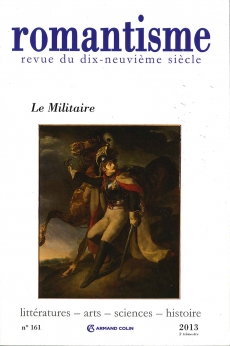
Romantisme n° 161 (3/2013)
Pour acheter ce numéro, contactez-nous
Recevez les numéros de l'année en cours et accédez à l'intégralité des articles en ligne.
Existe-t-il un type iconographique du soldat français ? Cet article propose d’étudier, à travers les écrits d’Armand Dayot (1851-1934), inspecteur des Beaux-Arts, critique, historien d’art puis directeur de la revue L’Art et les Artistes (1905-1939), la réception de la figure du militaire sous la Troisième République. Dans les années 1890, alors que l’armée républicaine tente de dépasser le souvenir de Sedan, le soldat français trouve une incarnation dans le grognard napoléonien tel qu’immortalisé par Charlet et Raffet au début du siècle. Si ce type subsiste durant la Première guerre mondiale, il est bientôt contesté par l’émergence de la figure de l’artiste-combattant. La réflexion des historiens et écrivains d’art du temps – notamment Robert de la Sizeranne, Arsène Alexandre et Gustave Geffroy – porte désormais moins sur le type du soldat que sur la légitimité de la représentation de la guerre. La réception de l’oeuvre du peintre Mathurin Méheut (1882-1958), acteur et témoin du conflit, est exemplaire de ce déplacement, qui oblige à repenser les modalités traditionnelles du genre militaire face à la guerre moderne.
Is there such a thing as an iconographic type for the French soldier ? This paper studies the reception of this military figure during the Third Republic in France, in Armand Dayot’s writings as editor of L’Art et les Artistes (1905-1939), art critic and art historian (1851-1934). In the 1890s, as the Republican army was trying to overcome the memories of the defeat at Sedan, Napoleonic grognards portrayed by Charlet and Raffet in the early 19th century contributed to the personification of the French soldier. While this iconography still existed during World War I, it was soon challenged by the new figure of the artiste-combattant. Art historians of that period – in particular Robert de la Sizeranne, Arsène Alexandre and Gustave Geffroy – began to focus on the legitimacy of the representation of war rather than on the figure of the soldier. The critical reception of the work of the painter and soldier Mathurin Méheut (1882-1958) exemplified this evolution, which led to a reconsideration of the traditional codes of military painting in representing modern conflicts.

